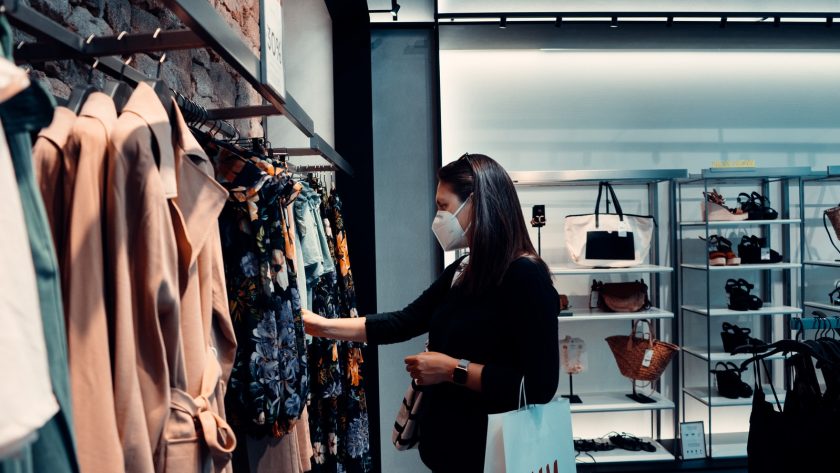Although a growing number of brands are shifting to recycled fibers, experts fear that people might believe their purchases are environmentally friendly when in fact they are not.
A material that can be woven into your clothes can take on many different forms. It can have the texture and lightness of wool, or silky smoothness. It is found in about two-thirds our clothing, and most people don’t know it. It’s made of plastic and is a huge problem.
About 69% of clothing today is made of synthetic fibres. This includes elastane and nylon, as well as acrylic. The most popular fiber, polyester, accounts for 52% of all fiber production. Plastic’s versatility and durability make it an indispensable material for the fashion industry.
“It’s everywhere, it’s in your jeans, your shoes and in almost everything else you wear. Because plastic is this miracle material,” George Harding-Rolls, campaign adviser at The Changing Markets Foundation, which investigates corporate practices.
There is a cost to the climate: fossil fuels are used as raw material for these fibres. The global oil consumption of textile production is 1.35%. This is more than Spain uses in one year. It also significantly contributes to climate change. The impact of synthetics continues long after they are produced, as they release plastic microfibers into our environment when we wash clothes.
A growing number of brands are now switching to recycled synthetic fibers such as polyester. They often advertise these clothes as being “more sustainable” or “conscious”.
This sounds like an environmental win. However, experts are questioning whether these brands are just attempting to cover up fashion’s environmental problems by using more recycled yarns in their garments. Maxine Bedat is the executive director of The New Standard Institute, which promotes a sustainable fashion industry.
Polyethylene terephthalate bottles (PET), the most widely used type of plastic bottles and the most commonly produced, are the best recycled substitute for virgin synthetics. The Changing Markets Foundation conducted a survey of almost 50 fashion brands and found that 85% of them aimed at sourcing recycled polyester from plastic containers. According to estimates, recycled polyester could lower emissions by as much as 32% when compared to virgin Polyester.
It is expected that the demand for recycled synthetics in fashion industries will increase. Nike uses some recycled material in 60% of its products, according to Seana Hannah, Nike’s vice president of sustainable innovation. Recycled polyester is the main focus. Hannah stated that Nike is the largest industry user of recycled plastic and diverts more than 1bn plastic containers a year from landfills.
Many large brands have set targets. Madewell, H&M, J Crew, and Gap Inc are just a few of the more than 70 brands that have pledged to increase recycled polyester’s share to 45% by 2025. This is part of the Textile Exchange’s “recycled polyester challenge”. The non-profit works to increase textile industry uptake of low-impact fibers.
According to Alice Hartley of Gap Inc’s director of product sustainability, synthetics are the second-largest source of fibers, after cotton. The brand’s four brands, Old Navy, Gap, Athleta, and Banana Republic have all committed to the 2025 Challenge. Old Navy has chosen to double its recycled polyester to 60%.
According to the company, recycled synthetics do not have the ability to solve all problems. “We try to avoid the term “sustainable garment” because it implies that we have reached our destination. Hartley stated that we haven’t reached the destination, and it’s a continuous process.
This nuanced message might not be reaching consumers as well as other brands that describe recycled fabrics as being sustainable. Experts fear that consumers may think their purchases are environmentally friendly, when in fact it is not.
Harding-Rolls stated that recycling synthetics doesn’t solve the problem of microplastics. He said that fibers continue to shed from recycled plastic yarns as much as they do from virgin yarns.
PET bottles can also be recycled in a closed loop system. Bedat stated that the apparel industry is “taking this closed-loop and moving it into this line system”, as most of these clothes can’t be recycled. Plastic bottles can be converted into clothes, which could accelerate the path to landfill, particularly for low-quality garments that are quickly discarded after only a few wears.
Ashley Gill, Textile Exchange senior director of standards & stakeholder engagement, stated that “greenwashing” is a way of taking one piece of the problem and extrapolating large benefits. “Sustainability is a complex issue in the apparel industry.”
There are moves to use recycled textiles as feedstock for new clothes – less than 1% of clothes are currently recycled into new fibers – especially as projections from some markets suggest that cross-industry demand for recycled bottles will soon outstrip supply. Most clothes are made with a variety of fibers and there isn’t yet a commercial-scale technology to separate them. Hartley stated that a whole supply chain is needed to reach the commercial volumes we need to produce more recycled fiber-tofiber textiles.
Bedat said that hyping the low emissions of recycled yarns distracts from fashion’s bigger emissions source: textile mills. These are responsible for 76% of a garment’s total lifecycle emissions. Bedat stated that brands are more focused on creating the most magical materials than improving energy efficiency in textile mills. While I don’t wish to downplay progress, we must prioritize where we can move the needle most.
Innovators believe that finding viable alternatives to fossil fuel-derived synthetics with the same performance characteristics is the key. Material science company Kintra Fibers has developed bio-based fibers from wheat and corn that can be fully composted in the natural environment. Alissa Baier Lentz, co-founder of the company, said, “That addresses microfiber issues, and provides another route for textile circularity.”
Baier-Lentz stated that the fiber can be recycled back to its base components and used as a feedstock in circular yarn production. She stated that it was up to us to create the recycling system and to work with industry partners to make this happen. To increase production of the compostable yarn, Kintra partnered in 2020 with Pangaia clothing company. The company will launch its first clothing made from Kintra fibers by 2022.
However, no single innovation will solve the complex plastics problems in fashion. Others believe that the solution lies in moving away from excessive production and consumerism. There are dozens of clothing collections produced by brands each year. In 2014, consumers bought 60% more clothing than in 2000, but only kept half the clothing for as long. Gill stated that Textile Exchange will be focusing some of its future industry challenges upon “slowing down growth rate” in clothing production.
To drive systemic, real change, legislation is needed, stated Harding-Rolls. “[The apparel industry] has one of the least regulated industries in all of the world. We need mandatory measures. It’s working in the plastics industry, so it’s time to make it work in the fashion space.”
Bedat said that there is a role for us too. It involves citizens seeing themselves as citizens capable of making ethical and political decisions. “We have been taught to view ourselves as consumers. This is the antithesis of the real solution.”






